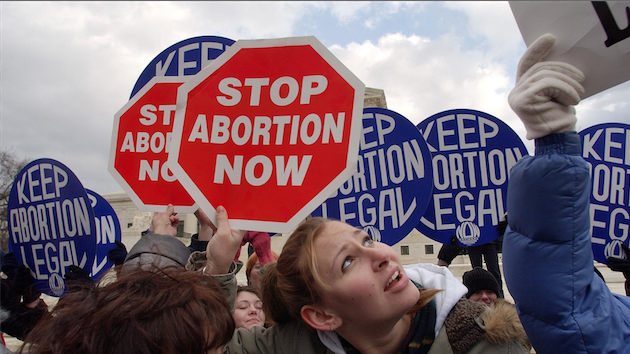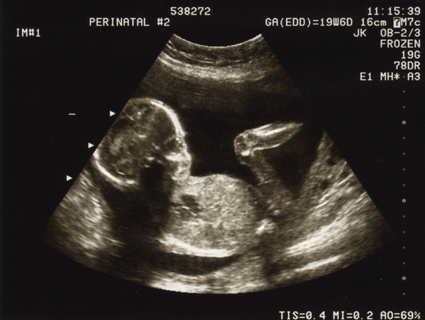
Gerald Herbert/AP
On Thursday, the New York Times carried a front-page story reporting new research that could have a profound impact on the nation’s abortion debate: a study concluding that a small number of premature infants born at 22 weeks can survive with intensive treatment.
The study, which appears in the New England Journal of Medicine, followed 5,000 infants born between 22 and 27 weeks of gestation. Seventy-eight of those infants were born at 22 weeks and given treatment to increase their chances of survival; 18 of them survived. Of the 18, which the researchers followed up on as toddlers, 6 experienced severe impairments, from blindness to debilitating cerebral palsy, and 7 were relatively healthy.
The news has huge implications for the the medical community, where there has been debate about how much treatment to provide to babies born at this stage of gestation. But it could also have sweeping consequences for the fight against abortion rights—giving abortion opponents new support for a popular abortion ban, while possibly undermining their quest to overturn Roe v. Wade, the 1973 Supreme Court decision that established a right to abortion.
In the immediate future, the news is most likely to impact the coming congressional debate over House Republicans’ proposed 20-week abortion ban, which many see as a direct challenge to Roe. In that ruling, the justices forbid the states from banning abortion before a fetus was viable outside the womb. A 20-week ban, mainstream medical groups have argued, bars abortion before viability.
But abortion foes may use this new study to argue that 20 weeks is indeed within the range of viability, and a ban on procedures after 20 weeks is legal. (When abortion opponents talk about 20-week bans, technically, they mean 22-week bans. Click here to read a full explanation.)
Viability, however, is not a bright red line. And this new research is less of a breakthrough and more of a rigorous confirmation of what smaller, less systematic studies have already observed. One such study found that 85 percent of infants born at 22 weeks (or 20 weeks, in political parlance) die within 12 hours. Another study found that 98 percent of 22-week-old infants are born with major health issues such as brain hemorrhaging, and 93 percent die within a year. (The University of California-San Francisco Medical Center, by contrast, states that no infants born earlier than 23 weeks have survived.) Some major medical groups have been debating whether to move average viability to 23 weeks from 24 weeks. But there are no signs that the study will cause medical organizations to set 22 weeks as the new average viability.
Abortion foes have always had dual motives for pushing 20-week abortion bans. (About 2 percent of all abortions would be affected by a 20-week abortion ban. About 13,000 women sought these abortions in 2011, the most recent year for which there is reliable data.) In public, they insist that these bans are only preventing abortions of viable infants. The majority of the medical community wouldn’t agree, but there is broad public support for the idea of banning abortion on viable pregnancies.
At the same time, as I reported earlier this year, 20-week bans are designed to bring a challenge to Roe v. Wade before the Supreme Court. In Roe, the justices ruled that states could not set a specific date for viability. (That determination was left up to doctors.) The legal wing of the abortion rights movement is fighting some 20-week bans, which have been passed in 10 states, on the grounds that they violate Roe. If one of those cases were to make it to the Supreme Court, it could be an opportunity for the justices to overturn Roe‘s viability standard altogether.
Here’s Samuel Lee, a former lobbyist for Missouri Citizens for Life, explaining how a measure he wrote, requiring doctors to perform viability tests before providing abortions to women who appeared to be at least 20 weeks pregnant, was designed to overturn Roe:
The 20 weeks gestational age was chosen to push the envelope on when the state’s interest in protecting the life of the unborn child could take place. It was designed as an opportunity to attack the Roe trimester framework, while still giving the Court some wriggle room (the statute required a determination of viability, not a prohibition of abortion after viability). It was an opportunity for the Court to discuss an interest by the state in protecting unborn human life earlier than the viability line of demarcation permitted…It was chosen because it was earlier than the earliest limits of viability at the time, but not so early that the unborn child could never be viable.
The Supreme Court upheld Lee’s provision in 1989. Later, Justice Thurgood Marshall’s papers revealed that the conservative majority in Webster had come within one vote of using the 20-week provision to strike down Roe entirely.
If the average age of viability were to inch backward toward 22 weeks—with this study being the first step—then 20-week abortion bans would cease to pose a broad constitutional challenge to Roe. At the time of its ruling, after all, the Supreme Court majority noted that average viability began at 28 weeks (the start of the third trimester), but it was possible that fetuses would someday be viable as early at 24 weeks.
In other words, the medical advances behind this new research don’t automatically undermine Roe—especially when it comes to something as nebulous as viability. But they may fuel the drive for a national 20-week abortion ban.
*Abortion opponents typically count the weeks of pregnancy from the date of fertilization, while the medical community uses the more rigorous method of counting the weeks of pregnancy from the start of a woman’s last menstrual period. In medical terms, then, the House Republicans’ 20-week abortion ban is actually a 22-week abortion ban. Unless we’re talking about the bans, this article uses the medical method of dating a pregnancy.












